| |
|
Saturday, May 17 Tifereth Israel Synagogue—Dizengoff Night


Sunday, May 18 Community Israel Independence Celebration

Wednesday, May 28 JFS~Ellen Saks lecture on mental illness
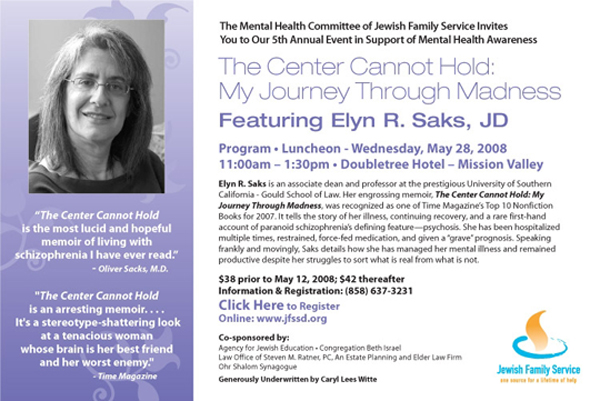

Tuesday, June 3 Guardians Golf & Tennis Tournament


Friday-Saturday, June 6-7 JFS~Judaism on the Wild Side

Sunday, June 8 Temple Solel~Tikkun Leil Shavuot


JERUSALEM DIARIES
Pollard, Jewish identity and the drosh — subjects on a Jerusalem evening stroll
By Judy Lash Balint
 JERUSALEM—Just when it's difficult to conceive of things getting any more intense or diverse than they were last week when we experienced the swift transition from the sadness and solemnity of Memorial Day to the joyfulness and celebration of Israel's 60th anniversary, along comes an evening where disparate events are juxtaposed in such close physical proximity that it's hard to assimilate it all. JERUSALEM—Just when it's difficult to conceive of things getting any more intense or diverse than they were last week when we experienced the swift transition from the sadness and solemnity of Memorial Day to the joyfulness and celebration of Israel's 60th anniversary, along comes an evening where disparate events are juxtaposed in such close physical proximity that it's hard to assimilate it all.
At the same moment that another Jewish woman was killed by a terrorist missile in southern Israel, several thousand Jerusalemites formed themselves into a human chain in front of the U.S Consulate two days ahead of the visit of President George W. Bush, to urge the American president to "free your captive—Jonathan Pollard."
The crowd spilled over to the square around the corner from Prime Minister Olmert's residence where a long list of speakers berated the Israeli government's lack of action as well as the intransigence of the American defense establishment in refusing to allow Pollard out of jail after 22 years punishment.
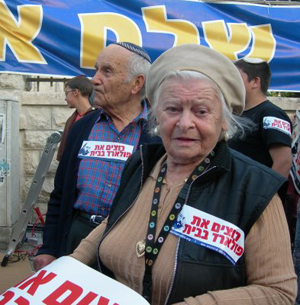 Amongst the crowd I spotted Mayer and Regina Mansdorf (photo at right) , a couple who are almost 90 years old, who both survived the Holocaust, emigrated once to America and then to Israel in the 1980s. They live close by and never miss the opportunity to speak out against injustice. Standing close to the spry elderly couple are a gaggle of teenage girls who lead the shouts of "Free Pollard, Free Pollard" that are quickly taken up by the large, mostly religious crowd. Amongst the crowd I spotted Mayer and Regina Mansdorf (photo at right) , a couple who are almost 90 years old, who both survived the Holocaust, emigrated once to America and then to Israel in the 1980s. They live close by and never miss the opportunity to speak out against injustice. Standing close to the spry elderly couple are a gaggle of teenage girls who lead the shouts of "Free Pollard, Free Pollard" that are quickly taken up by the large, mostly religious crowd.
Human rights lawyer Nitsana Darshan Leitner addresses the demonstrators, as does former Prisoner of Zion Yosef Mendelevich, who spent 11 years in a Soviet prison camp back in the 1970s.
Police photographers discreetly take photos of participants as a throng of border patrol and police officers ring the square.
About four blocks away at the beautiful Mishkenot Shaananim conference center, the evening session of the first Writers Festival gets underway. It takes no more than 10 minutes to walk between the rally and the festival, but the atmosphere and the crowd couldn't be more different. Several hundred fashionably dressed and largely secular types have gathered in the marquee overlooking Sultan's Pool and the walls of the Old City to listen in on a discussion between Israeli author Eshkol Nevo and American writer Jonathan Safran Foer, moderated by Israeli literary critic Noa Menheim. The audience is overwhelmingly female and surprisingly, not all made up of native English speakers.
The conversation focuses on Jewish identity and the nature of the conflict in Israel. Both authors are disarmingly frank and good-natured, even while they disagree over their perceptions of the major conflicts in Israeli society. Foer, an avowed secular Jew living in New York with an identity he says is shaped by eastern Europe, sees the crux of the matter here as the great divide between ultra-orthodox Jews and the rest of Israel. Nevo, Jerusalem-born and now living in Raanana, tells Foer the Haredim aren't a factor in his life, but ensuring a safe drive between Tel Aviv and Jerusalem is. "On the scale of conflicts that's number one," he states.
Nevo somehow weaves in the thought that Israelis aren't taught the "Arab narrative" in high school, and I decide it's time to leave. There's a book launch at the Conservative synagogue on Agron Street that I don't want to miss. The synagogue is just across the street from the Pollard protest, and as I walk by, Esther Pollard, Jonathan's wife is exhorting the remaining demonstrators to keep up their activities during the Bush visit.
The Moreshet Yisrael Synagogue is almost full as I slip into one of the few remaining seats at the back of the sanctuary. The evening is to mark the publication of the latest book by one of the congregation's emeritus rabbis, Avraham Feder. Rabbi Feder is a prolific author, lecturer and chazan and husband of my friend Tzipora.
After a learned introduction by Rabbi Yosef Green, Rabbi Feder's predecessor at Moreshet Yisrael, Rabbi Feder launches into a passionate, accessible and inspiring talk about the art of the darshan--one who gives a drasha. Rabbi Feder's new two-volume book is entitled Torah Through a Zionist Vision, and he tells us,"The Torah's Zionist call jumps out on every page." Last month when I spent Seder with the Feders, he told me with a sly smile that there wasn't a single Shabbat when he didn't mention aliya or Zionism in his drashot to his congregation in Toronto.
Tonight, Rabbi Feder, a powerful and extraordinarily effective communicator, closes his talk by noting the difference between delivering a drasha and writing a book. "In a drash you're dramatic, passionate--you yell a lot," he explains. "In a two volume book things are calmer, steadier, there's time to be more philosophical, it's a serene passion," he says.
The rabbi leaves us with the main point he says he's tried to get across by writing this book. There are no footnotes in his book--"I don't pretend to be a Biblical scholar." Rabbi Feder says he's taken a more literary approach inspired by a Bialik essay and focusing more on the revelatory aspects of Torah. "I hope this modern perush will help us realize what a precious gift we have," he concludes.
Three events within a half mile radius over a three hour period that draw hundreds of participants representing a panoply of perspectives and providing food for thought. Sign of a vibrant society or a fractured people??

Nancy Harrison
cruise & tour specialist
(619) 265-0808

PEOPLE OF THE BOOKS
Book examines biblical interpretations
Torah Through Time: Understanding Bible Commentary from the Rabbinic Period to Modern Times by Shai Cherry, Jewish Publication Society, Philadelphia; ISBN 978-0-8276-0848-1, 2007, $25; 231 pages
By Fred Reiss, Ed.D
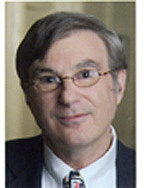 WINCHESTER, California—There are four paths to Jewish exegesis that collectively have the acronym PaRDeS. This Hebrew word, pronounced Pardes, means paradise. The P stands for the Hebrew word Peshat, which is the literal meaning of the text. The R stands for the word Remez, or hints, which go beyond the reading of the simple text. Some refer to this as the allegorical method. The third letter, D, represents Derash, connoting the idea of seeking or inquiring about the meaning of a given verse by comparing similar, but disparate biblical passages. Finally, the S stands for the word Sod, which translates into English as secret and often refers to the Kabbalistic or mystical meaning of the text. WINCHESTER, California—There are four paths to Jewish exegesis that collectively have the acronym PaRDeS. This Hebrew word, pronounced Pardes, means paradise. The P stands for the Hebrew word Peshat, which is the literal meaning of the text. The R stands for the word Remez, or hints, which go beyond the reading of the simple text. Some refer to this as the allegorical method. The third letter, D, represents Derash, connoting the idea of seeking or inquiring about the meaning of a given verse by comparing similar, but disparate biblical passages. Finally, the S stands for the word Sod, which translates into English as secret and often refers to the Kabbalistic or mystical meaning of the text.
Torah Through Time by author Shai Cherry is a case study of certain biblical stories and laws using Derash, which he translates as interpretation. By weaving historically important explanations of these stories and laws from the Mishnaic period (second to fifth centuries C.E) to modern times, Cherry shows that every generation of commentators has the ability to extract new meanings from previously interpreted text. He calls this the Botanical Model, making the analogy that just as figs do not ripen on a tree all at once, so all possible meanings of biblical verses show themselves only gradually, as circumstances dictate. For Cherry, the Bible is a living document.
Specifically, Cherry concentrates on five biblical stories: the creation of humanity (Genesis 1:26-31), Cain and Abel (Genesis 1:3-8, 13), The Hebrew slave (in post-Egyptian times), Korah’s rebellion (Numbers 16:1-7), and Zelophehad’s daughters (Numbers 27:1-7). Each chapter concludes with notes and a table, which summaries the problem that each commentator sought to resolve, how the commentator resolved it, through which textual mechanisms and under what historical circumstances, if any.
In the creation story, Cherry finds the earliest commentators concerning themselves with the question of “to whom is God speaking when He says, ‘Let us make man in our image after our likeness?’” Later, biblical interpreters focused on the individual words by asking, what does the Hebrew word Adam mean and what do the words likeness and image mean? By the twentieth century scholars wanted to know if, according to the creation story, women were initially obligated to procreate.
The chapter on the Hebrew slave is not really a specific story, but rather a set of sometimes contradictory laws found in different parts of the Old Testament. They include Exodus 21, Leviticus 25, and Deuteronomy 15. Initially the great commentators Rashi, Ibn Ezra and Ramban (all eleventh century C.E.) asked “why do the civil laws in the Bible begin with the laws of slavery?” In seventeenth century Poland, Shlomo Ephraim of Lunschitz concerned himself with understanding why the Bible required a Hebrew slave to be set free in the seventh year. The author, who refers to himself by the acronym Meshi, observes that part of Exodus 21 is written in the first person (I) and part in the second person (you). He concludes that this chapter shows that God distances himself from the act of acquiring a slave and actually recoils from the thought of enslaving another human being. In the chapter on the Hebrew slave, it is quite clear that Judaism has evolved from biblical morality to rabbinic morality. After all, the Bible says “an eye for an eye,” but the Rabbis say “the price of an eye for an eye.” Cherry quotes the recently deceased Israeli philosopher and scientist Yeshayahu Leibowitz, who wrote that these contradictory laws show that God intends that the Oral Laws, promulgated by the rabbis, supersede the laws in the Bible. Cherry follows this up with the interpretation of Rabbi Benjamin Scolnic, a contemporary pulpit rabbi from Connecticut, who sees biblical laws as God’s will in relation with concrete realities.
In Torah Through Time, the reader sees the changes in the methodologies of exegesis from one era to another. At first, scholars used the simple reading of the text. As time passed they relied more on contextual clues, grammatical irregularities, and allegory. After all, modern scholarship asserts that historically the Bible is interpreted on four assumptions: it cannot be understood through a superficial reading, it is eternally relevant, it is perfect and without error, and it has divine origins. Nonetheless, time and place also influence interpretation; among these are the evolutionary theory and materialist philosophy of the nineteenth century, human psychology and the contemporary feminist movement.
Zelophehad, from the Tribe of Manasseh, dies without male heirs just as land in Canaan was being assigned to the families of the twelve tribes. Zelophehad’s daughters come before Moses, pointing out that their family will receive no land and asking for Moses to intercede. Moses does not know what to do and prays to God, who replies that the daughter’s claims are just, and they must inherit their father’s land. The early twentieth-century Polish commentator, Aharon Greenberg, resting on existing beliefs about women, wrote that Moses appealed to God because women cry easily and Moses was afraid that the women’s tears would affect his judgment. By the end of the century, with the rise of the feminist movement, Dr. Elyse Goldstein, a Toronto Rabbi, noted that when Moses and the Israelites arrived in Canaan they saw that in other cultures women had the right to inherit, and so “even though the daughters of Zelophehad petitioned only for themselves, Moses hears in their protest the voices of other women, and does not want to answer the challenge himself.”
The use of the case study to understand biblical commentary is important because biblical exegesis is often studied as isolated assertions, devoid of time, place and historical circumstances. Someone who tries to understand biblical interpretations is often unaware of these important factors, which inform the problem under study and tone of the written opinion. Cherry deserves applause and approbation for writing Torah Through Time and adding another dimension of biblical scholarship for the lay person.

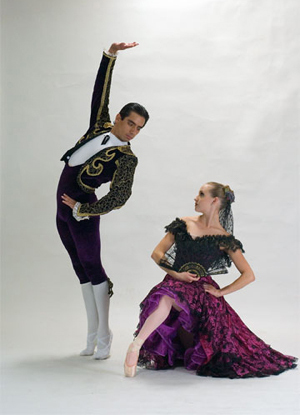 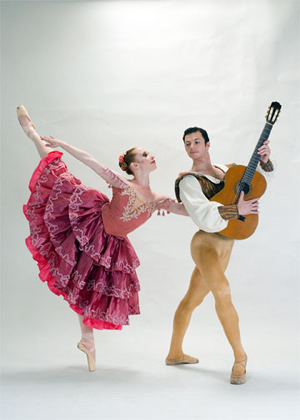
REFLECTIONS
City Ballet tilts and wins with Don Quixote
By Sheila Oryseik
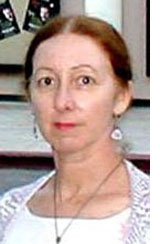 SAN DIEGO—The story of Don Quixote as a ballet has little to do with the original conception. Periodically the Cervantes caricature of chivalry dodders through the action, but isn’t really an essential part of it. The ballet could very well stand alone as a comedy of true love triumphing over a father only interested in marrying off his daughter to another caricature - the rather old, rather foolish, rich man of the village. All three - the father, the presumptive rich groom and the Don - belong to the past; true love is the future. Along the way we have the opportunity for a great deal of wonderful dance. SAN DIEGO—The story of Don Quixote as a ballet has little to do with the original conception. Periodically the Cervantes caricature of chivalry dodders through the action, but isn’t really an essential part of it. The ballet could very well stand alone as a comedy of true love triumphing over a father only interested in marrying off his daughter to another caricature - the rather old, rather foolish, rich man of the village. All three - the father, the presumptive rich groom and the Don - belong to the past; true love is the future. Along the way we have the opportunity for a great deal of wonderful dance.
Premiering in 1869 with Master Choreographer M. Petipa, the legendary Bolshoi Ballet, and with many other versions and revisions, the ballet has remained a favorite in the classical repertoire. One of the most famous pas de deux in all of ballet occurs in Don Quixote - a test of technical skill and flair for all who essay to dance it. However, when presented by itself as part of a gala show piece program - as it often is - one doesn’t get to see this jewel as it should be seen.
 City Ballet of San Diego, celebrating the close of its fifteenth season as it fulfills the hopes and plans of its Jewish founders, Steven and Elizabeth Wistrich; is performing one full length classical ballet after another as well as the works of the foremost choreographers of our time such as Balanchine. Straddling these two worlds - closely allied but requiring different approaches - is necessary if one wishes to be counted among classical ballet companies of worth and note. City Ballet has been more than successful thus far and this performance on May 11 at the Spreckels Theatre, San Diego, was part of that success. City Ballet of San Diego, celebrating the close of its fifteenth season as it fulfills the hopes and plans of its Jewish founders, Steven and Elizabeth Wistrich; is performing one full length classical ballet after another as well as the works of the foremost choreographers of our time such as Balanchine. Straddling these two worlds - closely allied but requiring different approaches - is necessary if one wishes to be counted among classical ballet companies of worth and note. City Ballet has been more than successful thus far and this performance on May 11 at the Spreckels Theatre, San Diego, was part of that success.
Artistic Director Steven Wistrich, undertook the character role of Don Quixote and played him not at all as the doddering fool he is too often presented to be. Wistrich played him with old elegance - the elegance of Wistrich’s own very fine training visible in his every gesture of hand and arm. The princely roles of the classical ballets may be behind him, but the beauty of his hands and arms, the placement of a foot - albeit encased within a character shoe rather than a ballet slipper - made the Don a true knight. He may have been out of his time, but because Wistrich made him a vehicle for dreaming of what had once been, not a cause for laughter, one could join the knight in his dream.
First my constant complaint - seemingly with every ballet company I’ve seen lately including the most renowned in the world - where oh where is the color? Why the constant persistence in earth tones - mauve - tan - brown - ecru? What happened to blazing red? Vibrant green? Sunshine yellow? Orange? The blue of  a cloudless sky? Peasants may have worn muted colors in the fields - but not for festivals - or weddings. I wanted Kitri’s dress to be red. Mercedes dress - though red - was a dark almost black-red. It’s hard to imagine Spanish folk dress in dim colors. a cloudless sky? Peasants may have worn muted colors in the fields - but not for festivals - or weddings. I wanted Kitri’s dress to be red. Mercedes dress - though red - was a dark almost black-red. It’s hard to imagine Spanish folk dress in dim colors.
Well, if the costumes - while pretty - were muted - the dancing was not. Janica Smith’s Kitri swished her way through the Act I - her fire cracker temps de fleche (step of the arrow) accented perfectly with the clapping. This ballet has a great deal of choreographed hand work with fans snapping open and shut - precisely. Throughout - both for the principals and the corps de ballet - it was a pleasure to watch.
Several male artists were engaged for this ballet and in the first act occasionally their timing was not quite in synch. It is difficult for men to dance exactly together since much of their choreography is jumping and turning. Each body has a slightly different impetus and trajectory. However, in the second act - the men created a wonderful picture as they flew through the air in a pas de Russe (Russian step) - absolutely perfectly. Every one of them was a pleasure in this dance.
Speaking of pleasures, both Tara Formanek and Kate Spaulding were splendid. Tara especially catches my eye with her delicious use of torso, epaulément (shoulders) and head. She really broadcasts how much fun she is having - and so one is happy to join her. She has long clean lines and I’d like to see her in some partnered adagio pieces. Spaulding is listed as an apprentice and this shows the company is developing strength in depth.
Cupid, danced by Megan Nichols, is another listed as “apprentice.” Her pas de bourrées shimmered such as I’ve seen on world class stages by world class companies. She is another showing the company’s strength in depth.
Act II was altogether a treat. The “dream” sequence fills the stage with totally classical ballet - no celebrating villagers. Here training and care is evident in every sense of those concepts. Line and shape, beauty and form - ballet at its most demanding - standing still, moving together - disparate bodies matching and dancing. Not a finger out of place.
Ariana Samuelsson, dancing Mercedes, was her usual terrific self. Her dancing is seamless, flowing and yet lingering. Ivan Bielik as Espada was a pleasure, too. Jesse Li as Queen of the Dryads, is another listed as an apprentice - she, too, is an upcoming treasure; dancing with panache.
Janica Smith (Kitri and Dulcinea) and Taurean Green (Basilio) gave a fine performance of the famous pas de deux; however Green was not always his usual smooth self - perhaps it was a bit of nerves. Smith whipped through her fouetté turns changing head spot every third one and ending with a double. She made this exhausting, unforgiving - and at breakneck speed - pas de deux look easy. In the first act as Kitri, I loved watching her peel off her foot as she stepped back in preparation for a tour jeté. So many forget that fine point of technique. But - smile, Janica - smile. Your dancing deserves a smile.
Green’s jeté tours around the stage and turns in grand a la second - were fine. He’s good enough that even if he has a ruffle here and there, he can save it as a professional does.
So many seemingly peripheral things to remark upon - seemingly peripheral but actually vitally important to the growth of a company and its professionalism. Good character action by the corps. A stage filled with women on pointe and mostly silent; no thumping to distract the viewer. The deepening strength in the ranks of dancers. Technique is not simply clean - it shines.
The music was taped and - thankfully - aurally comfortable. I always appreciate not being rattled in my chair.
And finally - this Don Quixote was a terrific way to finish the season and makes me look forward to the next.


THE JEWISH CITIZEN
Leftover matzah is no cocktail cracker
By Donald H. Harrison
 SAN DIEGO – The rest of you, no doubt, are counting the omer towards Shavuot. For me, the end of Passover is only now just nearing. SAN DIEGO – The rest of you, no doubt, are counting the omer towards Shavuot. For me, the end of Passover is only now just nearing.
 Our family finally opened our last leftover box of Osem Israeli matzah from the supply that we bought this year for Passover. We will use the matzahs within as cocktail crackers—we’ll serve them with cheese, or with hummus, or tuna fish, or maybe on other days with a slice of salami. Our family finally opened our last leftover box of Osem Israeli matzah from the supply that we bought this year for Passover. We will use the matzahs within as cocktail crackers—we’ll serve them with cheese, or with hummus, or tuna fish, or maybe on other days with a slice of salami.
Whatever, it won’t be pretty.
Matzahs never break evenly, and who wants to put a jagged piece of “hem-stitched cardboard” (as my late mother, Alice, used to call matzah) out on a party tray? So you have to work very hard trimming the matzah.
Matzahs also make terrible dippers. There is no cracker more likely to break right into the hummus, or the onion dip, so it is bound to leave lots of little crumbs. If you are using matzah with a dip, don’t forget a knife or spoon for spreading or ladling .
If you put a piece of cheese or (on different occasions, of course) meat on a matzah, the combination is guaranteed to break apart the moment that your guest bites into it. Crumbs will dribble onto the guest’s shirt or blouse. Other crumbs will fall first to the guest's chair and thereafter to your carpet.
So, be sure to keep handy your chief matzah accessory—a vacuum cleaner .
I always feel a bit guilty when I sweep up those crumbs and throw them out in the backyard for the birds. I can imagine them cawing and squawking, something to the effect of, ‘c’mon Harrisons, give us some chametz.”
Some people, like the birds, may find the cracker just a bit too dry. At our home, we sometimes use an old “Peruvian” recipe to deal with this problem. We take some matzah, spread some tomato sauce on it, then sprinkle on some cheese, and put it into the toaster oven. We call the result “Matzah Pizza” and tell our unsuspecting guests it was named after the Andean ruins at Machu Picchu.
Or, we take some cheese and some salsa and melt them on matzah in the toaster oven, and tell them it’s a Mexican specialty from “Matza-land,” a port not too far from Puerta Vallarta.
There’s a story about a fellow editor, who was blind, being handed a matzah at an informal staff get-together. He ran his hand over it once or twice. “Send this to the rewrite desk,” he ordered.
Ah, c'mon. I know what you’re thinking.

ADVENTURES IN SAN DIEGO JEWISH HISTORY
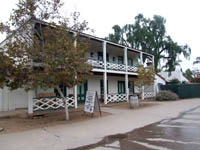
Robinson-Rose House
|
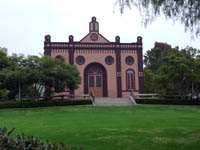
Old Temple Beth Israel |
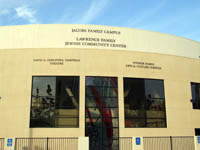
Lawrence Family JCC |
Editor's Note: We are reprinting news articles that the Southwestern Jewish Press ran in 1950. If you have historical topics about the San Diego Jewish community you would like us to explore, please e-mail your suggestions to editor Don Harrison at sdheritage@cox.net
San Diego Bnai Brith to Host Annual Convention
From Southwestern Jewish Press, July 21, 1950, page 1
San Diego B’nai B’rith men and women are in the final throes of preparation for the annual Grand Lodge District 4 Convention which will be held in San Diego from August 5 through August 9.
Edward A. Breitbard general chairman for the convention, has been hard at work with the Convention commission to insure the success of this 87th Annual Men’s and 28th annual Women’s District 4 Convention. Commission members who have been meeting Wednesday evenings in the U.S. Grant Hotel to report their progress, are drawn from all four groups of B’nai B’rith members in San Diego.
Convention Commission members are Ruth Aronoff, Bess Borushek, Morris Douglas, Zel Greenberg, Harry Mallen, Joe Martin, Ann Schloss, Dave Schloss and Jeri Starr.
Honorary Chairman is Henry Weinberger and Honorary Vice Chairman is Eli H. Levenson. Host Lodges and Chapters are San Diego Lasker Lodge No. 370; Samuel I. Fox Lodge No. 1747; San Diego Bridie Stodel Chapter No. 92; and San Diego Bay City Chapter No. 713.
Convention headquarters for the men will be the U.S. Grant Hotel while the women have the San Diego Hotel for their headquarters. In addition to the serious business of the Convention, the hosts are planning three social events during the Convention for the delegates, alternates and the visitors and local members of B’nai B’rith.
Drive Leaders in Plea to ‘400’
From Southwestern Jewish Press, July 21, 1950, page 1
Leaders in the San Diego United Jewish Fund Campaign last week broadcasted an earnest appeal to 400 members of the local community who so far have not subscribed in the current drive.
“On the basis of last year’s campaign and its contributions,” said Murray D. Goodrich and Nathaniel Ratner, “400 individuals who contributed in the 1949 Campaign so far have not made their subscriptions. We appeal to them to give now and help us in our stupendous effort to obtain the minimum $205,000 goal, which must be achieved.”
At the same time they made know that to date a total of $178,000 has been subscribed, leaving a balance of $27,000 which must be contributed in order to obtain the desired minimum.
In commenting on the “400,” who have not yet come forward with their subscription, the co0chairmen said:
“It is inconceivable that in this day and need, that this number does not intend to give. Doubtless they have procrastinated in signing their pledges, and do not realize the urgency of the situation. There must be some way to make them realize that every hour counts.”
Members of the Board of Directors of the United Jewish Fund are again out soliciting those contributors of $100 and over, who have not as yet made their contribution in 1950. A telephone, letter, and individual appeal, is being made to all those contributors of under $100, who have not as yet made their pledge in 1950.
Campaign leaders warned each of the “400,” that each day they delay in making their contributions, may very well mean a living death for a Jew who has an opportunity to migrate to Israel. Make your contribution now by mailing it to 333 Plaza, or by calling the united Jewish Fund, Franklin 0171.
Thrift Shop
From Southwestern Jewish Press, July 21, 1950, page 6
The summer months have not closed the doors of the Council’s Thrift Shop. The shop is being manned by Mr. and Mrs. V. Tolontino, new Americans who can speak Spanish, and volunteer workers from the membership of the Council of Jewish Women.
The Council has done a magnificent job in assisting the Émigré Committee of the United Jewish Fund to settle new Americans in San Diego. Through the Thrift Shop, it has clothed the newcomers, and supplied the necessities for them to start housekeeping.
In addition to the sale of the articles collected from the community, the Thrift Shop is used to store clothing, furniture and household supplies until needed.
Many new families are expected in San Diego and any assistance you can give at the beginning of their new life will go a long way toward helping them get a good start.
If you have furniture or clothing not in use, please contact either Estelle Levi, Chairman of the Thrift Shop at J-6385, or Martha Hollander, F-9-1782, F-1211.


SAN DIEGO JEWISH WORLD THE WEEK IN REVIEW
Shoshana Bryen in Washington DC: Europe is fatigued by moral issues like the Holocaust, Israel's existence
Donald H. Harrison in San Diego: Chabad Jewish Center, St. Therese Catholic Church share history, but not theology
Sheila Orysiek in San Diego: A 'New Look' is something I don’t need
Gary Rotto in San Diego: Here's how consumers can help eliminate Americans' dependence on foreign oil
Eileen Wingard in San Diego: Felder portrays Beethoven the man and Beethoven the musician at Old Globe
Adventures in San Diego Jewish History: What was the Jewish community news in 1950? Who were the newsmakers? Our archives answer these questions in daily installments
Shoshana Bryen in Washington DC: Naqba, or catastrophe, is propaganda; truth is Palestinians' self-imposed victimhood
Ulla Hadar in Kibbutz Ruhama, Israel: Mortar kills Kfar Aza man in his garden
Donald H. Harrison in San Diego: Jewish-named places in San Diego's news
Rabbi Baruch Lederman in San Diego: The Rosh Yehsiva's love for his talmadim
Sigal Shalev Peres in Hazeva, Israel: A Yom Ha'atzma'ut party to remember
Rabbi Leonard Rosenthal in San Diego: Some guidelines for synagogue dress
Ira Sharkansky in Jerusalem: Olmert inquiry focuses on dealings with American fundraiser Moshe Talansky
Adventures in San Diego Jewish History: What was the Jewish community news in 1950? Who were the newsmakers? Our archives answer these questions in daily installments
Shoshana Bryen in Washington DC: Israel at 60 continues to bend over backwards to accommodate neighbors
Cynthia Citron in Hollywood: Credit Sweetest Swing in Baseball with RBI
Ulla Hadar in Kibbutz Ruhama, Israel: Austria's president tells Israeli delegation of his sympathy for Sha'ar Hanegev residents
Donald H. Harrison in San Diego: Hebrew Day takes virtual tour of Israel
Sheila Orysiek in San Diego: Chapter Seven in the serialization of her novel, Reluctant Martyr
Adventures in San Diego Jewish History: What was the Jewish community news in 1950? Who were the newsmakers? Our archives answer these questions in daily installments
Shoshana Bryen in Washington, D.C.: King Abdullah points out Rice's folly
Donald H. Harrison in San Diego: SDJA students, faculty join worldwide quest to be largest group singing at the same time
Rabbi Dow Marmur in Toronto, Canada: Oh, Canada: Do you honestly think that Jerusalem is not a real part of Israel?
Sheila Orysiek in San Diego: The day that Israel became a nation
Cheryl Rattner-Price in La Jolla, California: JCC features work of 8 women artists
Hal Wingard in San Diego: His song, "Noah"
San Diego Jewish World staff in San Diego: Jay Winheld, CPA and Jewish volunteer, dies at 71.
Adventures in San Diego Jewish History: What was the Jewish community news in 1950? Who were the newsmakers? Our archives answer these questions in daily installments
Judy Lash Balint in Jerusalem: The anticipation of Yom Hazikaron
Donald H. Harrison in San Diego: San Diegans and Israelis join in their grief for the casualties of war and of terror
Evelyn Kooperman in San Diego: San Diego Jewish Trivia: Authors
Cantor Kathy Robbins in Cardiff-by-the-Sea, California: Im Tirtzu: Hold Fast to Dreams
Adventures in San Diego Jewish History: What was the Jewish community news in 1950? Who were the newsmakers? Our archives answer these questions in daily installments
< BACK TO TOP
|
|
